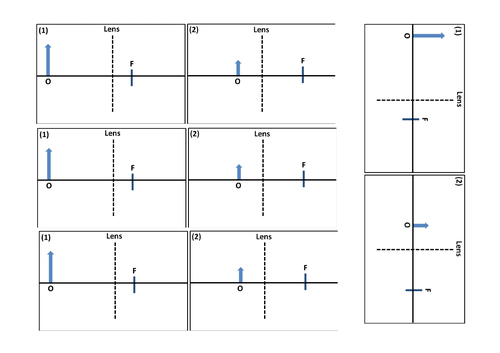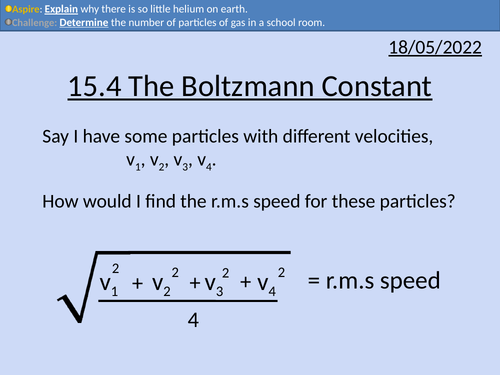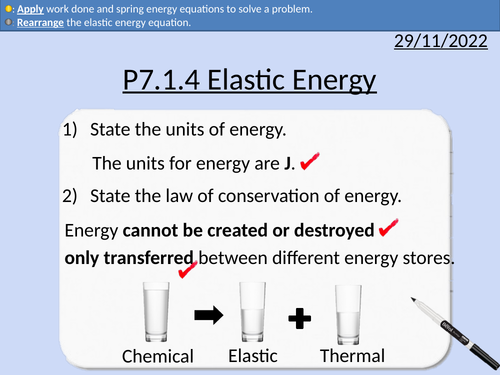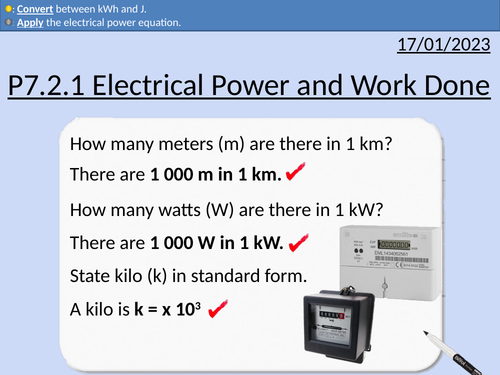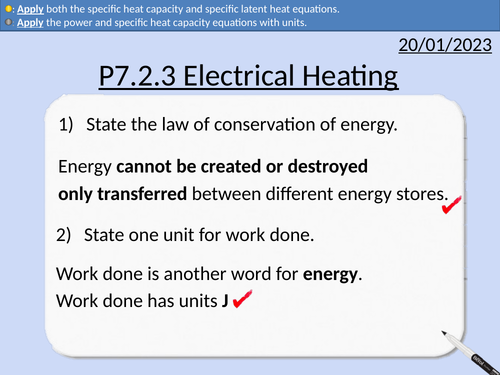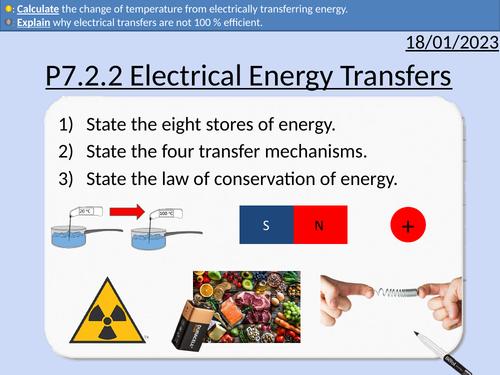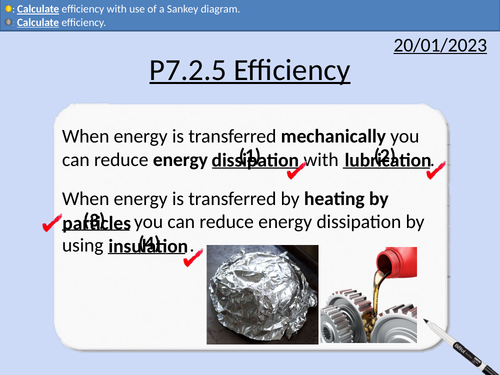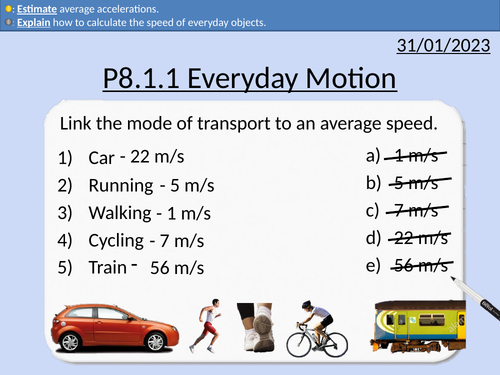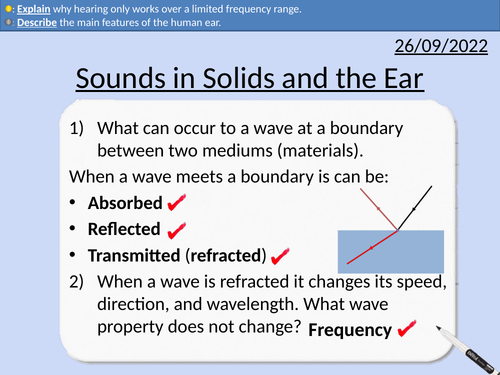497Uploads
169k+Views
72k+Downloads
Physics

OCR AS Physics: Internal Resistance
OCR AS Physics: Internal Resistance is a part of the Module 4: Electrons, Waves, and Photons. PowerPoint with worked examples and homework.
Find lost volts and terminal potential difference from a source of emf
Calculate internal resistance of a cell
Calculate internal resistance of a cell with a graph
Calculate EMF of a source

OCR AS Physics: Wave Properties
OCR AS Physics: Wave Properties is a part of the Module 4: Electrons, Waves, and Photons. PowerPoint with worked examples and homework.

GCSE Physics: Electrical Current
This presentation covers OCR Gateway Physics 9-1 P3.1.2 Electrical Current
Conditions for current to flow
Conventional current and electron flow
Measuring current with ammeters
Current at junctions
Converting from mA to A
Rearranging equations
Determining current and charge flow with equation

GCSE OCR Physics: Circuit Calculations
This presentation covers OCR Gateway Physics 9-1 P3.2.6 Circuit Calculations.
Measuring current and potential difference
Adding resistors in series and parallel
Rearranging Ohm’s Law
Rules for series circuits
Worked solutions to series circuit exam questions
Rules for parallel circuits
Worked solutions to parallel circuit exam questions

GCSE Physics: Transformers
This lesson presentations covers OCR Gateway Physics 9-1 P4.2.5 Transformers.
Examples of transformers in everyday life
Structure of a transformer Step-up and Step-down transformers
Transformer equation and rearranging equations.
Worked Examples and Student problems with worked solutions.
Explanation for use of step-up transformers - efficiency

GCSE Physics: Density
This presentation covers OCR Gateway Physics 9-1 P1.2.1
Presentation includes
Calculating volume for regular shapes
Conversion from grams (g) to kilograms (kg) and centimetres (cm) to meters (m) with exercise and answers
Converting with standard form with examples and solutions
Applying the density equation with examples and solutions
Proportionalities
Plenary exam question and solution

GCSE Physics: Density Practical
This presentation covers OCR Gateway Physics 9-1 P1.2.1
Presentation includes
Conversion from grams (g) to kilograms (kg) and centimetres (cm) to meters (m) with exercise and answers
Finding volume of regular and irregular shapes
Plenary Exam Question and Answer

GCSE Physics: Pressure and Surface Area
This presentation covers OCR Gateway Physics 9-1 P1.3.2 Pressure and Volume
This presentation includes:
Calculating surface area
Pressure equation with worked example
Rearranging pressure equation
Pressure equation problems with full solutions

GCSE Physics: Pressure and Volume
This presentation includes:
Pressure x Volume = Constant
Worked Examples
Plotting of pressure-volume graph
Explanation of increasing energy and temperature with bike pump

GCSE Physics: Lenses
This presentation covers OCR Gateway Physics 9-1 P5.3.2
Includes student activities and full worked answers.
Convex and Concaves lenses
Eyes and corrective lenses
Refraction and wavelength
Focal points for lenses
Determining the type of images produced through a lens

OCR A level Physics: Internal Energy
OCR A level Physics: Internal Energy is a part of the Module 5: Newtonian World and Astrophysics. The PowerPoint presentation includes worked examples, solutions and a homework.

OCR A Level Physics: The Boltzmann constant
OCR A Level Physics: The Boltzmann constant presentation with homework and answers

GCSE Physics: Work Done and Elastic Energy
This presentation covers OCR Gateway Physics 9-1 P7.1.4 Work Done and Spring Energy.
Use of Springs
Measuring Extension of a Spring
Rearranging Spring Energy Equation
Rearranging Kinetic Energy Equation
Practice Questions with Worked Solutions

GCSE Physics: Electrical Power and Work Done
This presentation covers OCR Gateway Physics 9-1 P7.2.1 Electrical Power and Work Done. All presentations come with student activities and worked solutions.
Definition of power
Converting between W and kW
Converting between seconds, minutes, and hours
Calculating work done in kWh and J
Converting between kWh and J

GCSE Physics: Electrical Heating
This presentation covers OCR Gateway Physics 9-1 P7.2.3 Electrical Heating Transfers. All presentations come with student activities and worked solutions.
Walls and Insulation
Thermal energy dissipation
Reducing thermal energy dissipation with lubrication and insulation
Heating substances and state changes
Work done = Power x Time
Change in thermal energy = Mass x Specific Heat Capacity x Change in temperature
Thermal energy for state change = Mass x Specific latent heat

GCSE Physics: Electrical Energy Transfers
This presentation covers OCR Gateway Physics 9-1 P7.2.2 Electrical Energy Transfers. All presentations come with student activities and worked solutions.
Energy stores
Energy transfers
Current heats wires
Wasted energy in motors and heating elements
Specific heat capacity and electrical energy
Thermal energy = Mass x Specific Heat Capacity x Change in Temperature
Energy = Charge x Potential Difference

GCSE Physics: Efficiency
This presentation covers OCR Gateway Physics 9-1 P7.2.5 Efficiency.
All presentations come with student activities and worked solutions.
Efficiency Ratings
Improving efficiency with insulation and lubrication
Maximum efficiency
Efficiency equation
Sankey diagrams

GCSE Physics: Everyday Motion
This presentation covers OCR Gateway Physics 9-1 P8.1.1 Everyday Motion. All presentations come with student activities and worked solutions.
Average speeds of walking, running, cycling, cars, trains, wind, sound, and light.
The speed equation
The acceleration equation
Explaining average speed camera
Explaining instantaneous speed camera
Estimating everyday accelerations
Calculating speed from rotation speed and circumference of wheels
Converting from miles per hour to meters per second

GCSE Physics: Forces in Collisions
This presentation covers OCR Gateway Physics 9-1 P8.1.4 Forces in Collisions. All presentations come with student activities and worked solutions.
Large accelerations produce large forces.
Values of g that cause severe injury or death
Road Safety
Newton’s First Law and seat belts
Crumple zones
Force = Mass x Acceleration
Acceleration = Change in velocity /Time taken
Estimating speed, accelerations and forces involved in large accelerations for everyday road transport.

GCSE Physics: Sounds in Solids and the Ear
This presentation covers OCR Gateway Physics 9-1 P5.1.4 Sound in Solids and the Ear. Includes student activities and full worked answers.
Structure of the ear.
Frequency range of human hearing.
Explanation of the limited frequency range of humans.
Explanation for hearing deteriorating with age.










